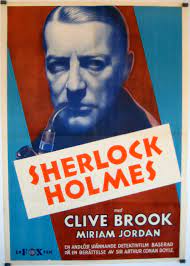
Sherlock Holmes (Clive Brook) is retiring from detective work. His archenemy Dr. Moriarty (Ernest Torrence) is in prison and has been sentenced to death. Holmes is engaged to marry Alice Faulkner (Miriam Jordan) and now that Moriarty has been dealt with this is the perfect time to get married and live a quiet life in the country. Circumstances, however, interfere in his plans.
Before being sentenced Moriarty had vowed to take revenge on Prosecutor Erskine, Lt Colonel Gore-King (Alan Mowbray), from Scotland Yard, and Sherlock Holmes. Moriarty promises that they will all die before he does. Before the Crown can hang him, Moriarty escapes from prison and goes on the run. The first to be killed is Prosecutor Erskine. His plans for Gore-King and Holmes are more involved.
Meanwhile, Moriarty begins to gather together the heads of several gangs of international criminals. Among them are Hans Dreiaugen (Lucien Prival) from Berlin, Manuel Lopez (Roy D’Arcy) from Madrid, Gaston Roux (Robert Graves) from Paris, and Homer Jones from Chicago. The Americans start up a protection racket with some of the shop owners. Moriarty is using them as a ruse to keep the police busy while he launches a more diabolical plan. He’s going to rob the bank owned by Alice Faulkner’s father (Ivan F. Simpson).
“Sherlock Holmes” AKA “Conan Doyle's Master Detective Sherlock Holmes” was released in 1932 and was directed by William K. Howard. It is an American pre-code mystery film. The movie was based more on the William Gillette stage play “Sherlock Holmes” than on any story Conan Doyle penned. The film stars Clive Brook as Sherlock Holmes and Reginald Owen as Dr. Watson.
This version of Sherlock Holmes is obviously different from the normal interpretation. This Holmes is engaged to be married. That may be a little strange these days but the play that the film is more or less based on also had Holmes with a fiancé. The play, with William Gillette playing the lead, was done over 1300 times so audiences in the early 1900’s were use to this added quirk. The play received the blessing of Conan Doyle himself so this adaptation is really not as strange as it may seem.
The added character of Billy (Howard Leeds), the kid that Holmes takes under his wing, is rather annoying and Reginald Owen as Dr. Watson is underused. Outside of Brook as Holmes, Torrence as Moriarty is probably the best in the film. Once you get used to the added characters the overall movie is done rather well. The cinematography is good and the use of light and shadow is very effective at giving the movie an eerie is not noir feel. That alone makes up for some of the badly done home spun aspects of the film.
Reginald Owen, who plays Dr. Watson, would go on to play Sherlock Holmes the next year in “A Study in Scarlet” 1933. He is one of a few people who would play both Sherlock Holmes and Dr. Watson. Jeremy Brett played Watson on stage in the U.S. and Holmes on British television. Carleton Hobbs played both Watson and Holmes in British radio adaptations and Patrick Macnee played both roles. He played Holmes in a Canadian made for TV film, “The Hound of London” 1994, and Watson in three U.S. television movies, "Sherlock Holmes in New York" 1976, "Sherlock Holmes: Incident at Victoria Falls" 1992, and "Sherlock Holmes and the Leading Lady" 1991.

